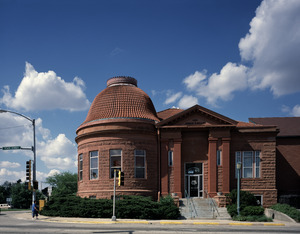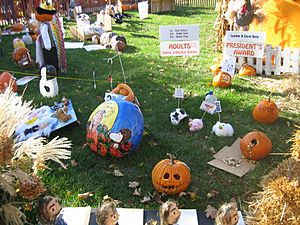Sycamore, Illinois facts for kids
Quick facts for kids
Sycamore
|
|
|---|---|
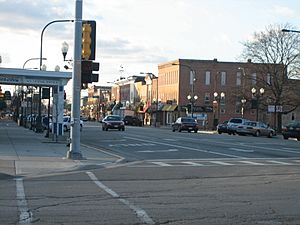
Downtown Sycamore, looking west from the intersection of State and Main streets
|
|
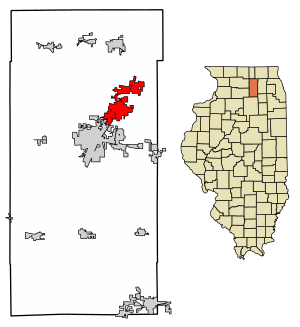
Location of Sycamore in DeKalb County, Illinois
|
|
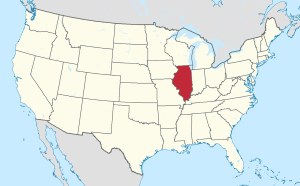
Location of Illinois in the United States
|
|
| Country | United States |
| State | Illinois |
| County | DeKalb |
| Named for | Sycamore tree |
| Area | |
| • Total | 10.18 sq mi (26.36 km2) |
| • Land | 10.12 sq mi (26.21 km2) |
| • Water | 0.06 sq mi (0.15 km2) |
| Population
(2020)
|
|
| • Total | 18,577 |
| • Density | 1,835.67/sq mi (708.73/km2) |
| Time zone | UTC−5 (CST) |
| • Summer (DST) | CDT |
| ZIP Code(s) |
60178
|
| Area code(s) | 815 |
| FIPS code | 17-74223 |
| Wikimedia Commons | Sycamore, Illinois |
Sycamore is a city in DeKalb County, Illinois, United States. It has a main shopping area along Illinois Route 64. In 2020, about 18,577 people lived there. Sycamore is the county seat of DeKalb County. It was named after the sycamore tree.
Contents
History of Sycamore
Early Settlers Arrive
The first European settlers came to the Sycamore area in 1835. They mostly settled north of the Kishwaukee River. The river's name means "Sycamore." Christian Sharer from New York planned the first town. A mill was built, and the Kishwaukee River was dammed. But this first town did not succeed.
By 1837, the county seat was chosen. It was Orange, which was Sycamore's first name. The settlement then moved to where the city is today. James Waterman and Evans Wharry planned the current town site in 1837. This was the same year Chicago was founded. Carlos Lattin was the first settler at the new site. He arrived in 1835. Lattin claimed land that is now most of the west side of the city. He built his first cabin just north of downtown.
Choosing the County Seat
In the early days, it was not certain that Sycamore would be the DeKalb County Courthouse location. Other towns wanted to be the county seat. A town called Brush Point was a choice for Dr. Henry Madden. The Clerk of the Court, Rufus Colton, wanted Coltonville to be the county seat. He lived there.
Colton held the first county court session at his home in Coltonville. He tried to make Coltonville the county seat. He held a new election in 1837. Colton only told people in Coltonville about it, so they would win. But the Illinois General Assembly stopped his plan. The DeKalb County court stepped in. When court met, the sheriff delivered a court order. It said Sycamore had built a courthouse. So, the court session had to be held there. Coltonville and Brush Point later disappeared. This settled where the courthouse and county seat would be for a while.
In 1903, the county planned a new courthouse. The debate over the county seat started again. This time, DeKalb wanted to be the county seat. Two important citizens from DeKalb, Jacob Haish and Isaac L. Ellwood, offered $20,000 each. This money would help pay for the new building. Sycamore raised its own money. After some arguments and legal steps, Sycamore won again.
Growth and Development
After the county seat issue was settled in 1839, the first DeKalb County Courthouse was built. Sycamore's first hotel was also built. A year later, the town had 12 houses. By 1844, it had 18 houses. Sycamore then started to grow steadily. The population increased each year. In 1848, it was 262 people. By 1851, it was 435.
The Sycamore and Cortland Railroad arrived in the late 1850s. A train station was built in Sycamore. By 1855, Sycamore had 41 businesses. In 1858, Sycamore became a village. After the American Civil War, the railroad helped Sycamore grow even more. In 1869, it officially became a city.
2010 Earthquake
On February 10, 2010, at 3:59 a.m., an earthquake happened near Sycamore. An earthquake is when the ground shakes. This earthquake had a magnitude of 3.8. Its strongest shaking was rated as IV (Light). People felt it as far as 133 mi (214 km) away in Madison, Wisconsin.
At first, people thought Sycamore was where the earthquake started. But later, data from the USGS showed it was closer to Virgil. This was the first earthquake in Northern Illinois since 2004. That one was a bit stronger, at magnitude 4.2.
Geography of Sycamore
Sycamore is located along Illinois Route 64. This road is called State Street in Sycamore. It is about 35 miles (56 km) southeast of Rockford. It is also about 55 miles (89 km) west-northwest of Chicago. The city is on the south bank of the East Branch of the South Branch Kishwaukee River. This river is in DeKalb County.
In 2021, Sycamore had a total area of about 10.18 square miles (26.37 km2). Most of this area, about 10.12 square miles (26.21 km2), is land. Only a small part, about 0.06 square miles (0.16 km2), is water. The land around Sycamore is gently rolling. It has rich soil that used to be covered in thick forests.
Sycamore's Cityscape
Sycamore's main business area is along Illinois Route 64. It stretches for about a mile. It starts where Route 64 meets Illinois Route 23. It ends at Center Cross Road. This area has two-story shops, a bank, and a small movie theater. It also used to have the Midwest Museum of Natural History. The city also has the county courthouse. It was built in 1904 from limestone.
People of Sycamore
| Historical population | |||
|---|---|---|---|
| Census | Pop. | %± | |
| 1850 | 338 | — | |
| 1860 | 1,271 | 276.0% | |
| 1870 | 1,967 | 54.8% | |
| 1880 | 3,028 | 53.9% | |
| 1890 | 2,987 | −1.4% | |
| 1900 | 3,653 | 22.3% | |
| 1910 | 3,926 | 7.5% | |
| 1920 | 3,602 | −8.3% | |
| 1930 | 4,021 | 11.6% | |
| 1940 | 4,702 | 16.9% | |
| 1950 | 5,912 | 25.7% | |
| 1960 | 6,961 | 17.7% | |
| 1970 | 7,843 | 12.7% | |
| 1980 | 9,219 | 17.5% | |
| 1990 | 9,708 | 5.3% | |
| 2000 | 12,020 | 23.8% | |
| 2010 | 17,519 | 45.7% | |
| 2020 | 18,577 | 6.0% | |
| U.S. Decennial Census | |||
The 2020 census counted 18,577 people living in Sycamore. There were 7,083 households and 4,602 families. The city had about 1,825 people per square mile. There were 7,792 housing units.
Most people in Sycamore were White (83.03%). Other groups included African American (3.20%), Native American (0.46%), and Asian (2.25%). About 9.31% of the population was Hispanic or Latino.
About 32.5% of households had children under 18. About 47.45% were married couples. The average household had 3.12 people. The average family had 2.51 people.
The median age in the city was 37.0 years old. About 24.8% of the people were under 18. About 13.7% were 65 or older.
The median income for a household was $65,924. For a family, it was $82,318. About 9.6% of the population lived below the poverty line. This included 11.2% of those under 18.
Economy of Sycamore
Sycamore has never had many large factories or industries. Some of its early businesses included Marsh Harvester Manufacturing. There was also R. Ellwood Manufacturing and Sycamore Preserve Works. Marsh Harvester started in 1859. Ellwood started in 1875. The preserve works began in 1891. R. Ellwood Manufacturing moved to DeKalb in 1891.
Today, Ideal Industries is based in Sycamore. It is a privately owned company that makes tools and equipment.
Arts and Culture in Sycamore
Fun Things to Do
Sycamore hosts the yearly Sycamore Pumpkin Festival. This festival started in 1962. A local resident named Wally Thurow began by showing pumpkins on his front lawn. The festival has many activities, a carnival, and a parade. The lawn of the DeKalb County Courthouse is the main spot. It has a display of decorated and carved pumpkins. Thousands of people come to Sycamore for this event. They come from northern Illinois, the Midwest, and other parts of the United States.
The city also has the Sycamore Historic District. This area has over 200 interesting old buildings. It was added to the National Register of Historic Places in 1978. The district covers parts of Main and Somonauk Streets. It includes much of the downtown shopping area and homes. In the summer, the Sycamore Historical Society offers walking tours. A local historian leads these tours.
Sycamore was also home to the Midwest Museum of Natural History. It had a collection of stuffed animals. The museum closed in February 2020.
The Great Western Trail (Illinois) is a path that goes through the town. You can walk or bike on it.
Historic Sites to See
-
David DeGraff House (1867) in the Sycamore Historic District
-
Frederick Townsend Garage (1905)
Education in Sycamore
Public schools started in Sycamore as early as 1839. Classes were held in the first DeKalb County Courthouse. This was a log building across from where the courthouse is now. The city's first school building was built in 1853.
Today, public education in Sycamore is managed by Sycamore Community Unit School District 427. Steve Wilder is the current Superintendent. The district has Sycamore High School, Sycamore Middle School, and five elementary schools. The newest elementary school, North Grove, opened in 2009. It was built for easy access by a nearby neighborhood.
Transportation in Sycamore
DeKalb Public Transit offers bus service in Sycamore. Routes 17, 18, 21, and 21T connect Sycamore to downtown DeKalb and other places.
Famous People from Sycamore
- David Boies, a well-known attorney, was born in Sycamore.
- Bryan Carter, a musician, lived in Sycamore. He won a Grammy and a Tony Award.
- Adam C. Cliffe, a United States court judge.
- Reuben Ellwood, a Republican U.S. Representative from Illinois. He is buried in Elmwood Cemetery.
- William J. Fulton, Chief Justice of the Illinois Supreme Court, lived in Sycamore.
- Jay Henigan, a plumber and CIA contractor.
- Mark Johnston, a former football player for the Houston Oilers, was born in Sycamore.
- Ben Niemann, a linebacker for the NFL's Tennessee Titans. He won the Super Bowl 2020 with the Chiefs.
- Nick Niemann, a linebacker for the Los Angeles Chargers.
- Maria Ridulph (1950–1957), a young person who was a victim of a crime.
- Alvah Sabin, a politician and congressman, lived in Sycamore.
- Frederick B. Townsend, a judge and mayor of Sycamore.
- Floyd K. Whittlemore, Illinois state treasurer.
- David A. Wirsling, an Illinois representative and farmer, was born in Sycamore.
- George McCaskey, chairman of the Chicago Bears football team.
See also
 In Spanish: Sycamore (Illinois) para niños
In Spanish: Sycamore (Illinois) para niños


